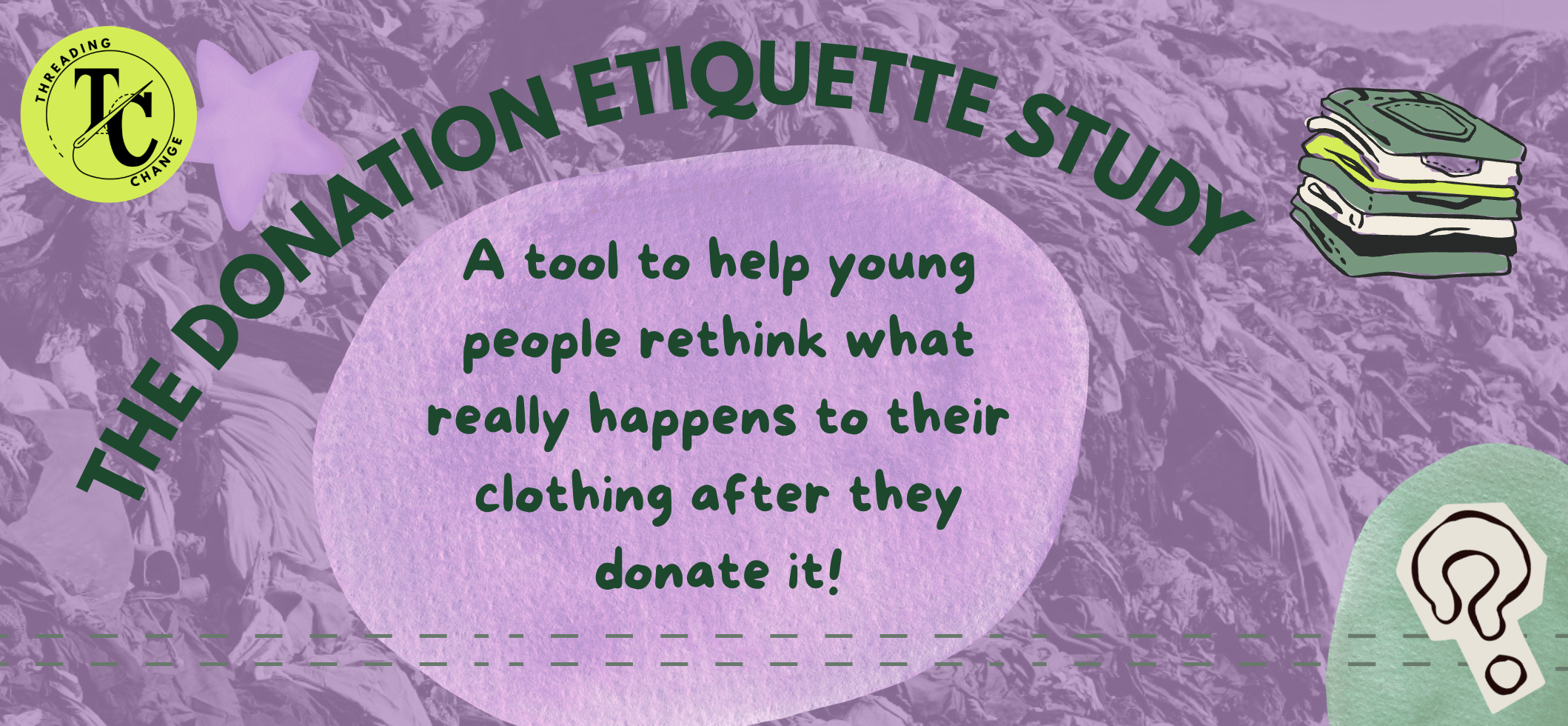DONATION ETIQUETTE STUDY
DONATION ETIQUETTE STUDY
It’s winter – time for the annual clothing swap. You drag your box of cold-weather clothes out of storage, sift through the layers, and spot a tiny stain on a sweater you’ve slowly fallen out of love with. The fit isn’t quite right anymore, so you toss it into a tote bag destined for the local thrift store. “Someone can make something out of this,” you assure yourself.
But here’s the twist: that sweater has a 70% chance of heading straight to the landfill, not into the arms of another thrift enthusiast. And no — this isn’t your fault. How could you have known what really happens behind the scenes of secondhand fashion?
OUR GOAL
Our goal is to empower youth with the knowledge, tools, and cultural awareness needed to make responsible, informed decisions about clothing donations. By uncovering what really happens to textiles after we let them go, DESP aims to reduce unwearable donations, divert clothing from landfills, and build a more sustainable, culturally respectful donation system across Canada.
We’re reimagining how youth understand clothing, culture, and responsible giving through our Tri-Impact Model of Consultation, Legislation and Innovation.
The Donation Etiquette Study Project (DESP) helps young people rethink what really happens to their clothing after they donate it and understand how misplaced donations can have a huge impact on their local community and global movements. Through hands-on workshops, youth-led polling, and community conversations, DESP uncovers what ethical donation and textile stewardship truly can look like.
We aim to explore how donation systems intersect with culture, identity, waste, and the environment, giving youth the tools to make informed, sustainable, and culturally respectful choices, thus reducing waste.
The Secret Lives of Secondhand Sweaters

The global fashion system is producing clothing at pace the planet cannot keep up with. According to Greenpeace, more than 100 billion garments were made worldwide in 2014, with production expected to surpass 200 billion soon. Most of today’s clothing is made from polyester, rayon, and other synthetics — plastics that do not biodegrade.
This overproduction fuels an unprecedented textile waste crisis.
In Canada, nearly 280 kilotons of synthetic textiles were discarded in 2020 alone.
In the U.S., 17 million tons of textile waste are generated every year, with only 15% recycled.
With so much waste, donation systems have become an unintended pressure valve. Many people assume that donating clothes is automatically helpful. But donation bins now receive far more clothing than they can process, and much of it is unsellable, contaminated, or low-quality.
The result?
Items are downcycled, landfilled, or shipped abroad.
Countries such as Kenya and Ghana absorb the overflow of Global North textile waste.
Kenya imported 177,664 tonnes of used clothing in 2022 alone—Canada among the top sources.
This creates environmental, cultural, and economic burdens for receiving nations.
Our goal is to understand what Canadians believe happens when they donate clothing, identify gaps in “donation etiquette,” and strengthen public awareness around textile waste and its consequences.
Misunderstandings lead to:
Overflowing or contaminated donation bins
Unusable clothing burdening charities, NGOs, and local thrift shops
Increased landfill waste
Loss of cultural textiles and knowledge
Reinforcement of global inequities, as receiving countries manage the waste of wealthier nations
Our African Regional Coordinator, Janet, offers an in-depth look at how secondhand clothing from the Global North moves through East African markets, revealing both the opportunities it creates and the burdens it places on local communities. Her piece underscores why DESP centres partnership and listening — acknowledging the complexity of these systems and the importance of working collaboratively with African leaders and organizations.
What Youth and their Communities Will Learn
What Youth and their Communities Will Learn
Participants, focus groups and community sessions will explore:
What actually happens to donated clothing
How donation systems differ across Canada
Cultural and identity loss in today’s fashion system
Environmental and social impacts of textile waste
Barriers to reuse, repair, and responsible giving
How they can lead change in their communities
Youth contribute to an anonymous Canada-wide dataset, making them co-creators of the future toolkit.
How We’re Doing It
Victoria, BC Pilot (2025–2026)
Led by Sophie Koser and funded by the CRD Rethink Waste Grant, our first DESP pilot includes:
Workshops for youth ages 18–35
Youth-led polling on donation habits and beliefs
Development of a Donation Etiquette Toolkit
Insights to inform our 2026–2027 national expansion
GET INVOLVED
GET INVOLVED
Want to bring DESP to your community, collaborate, or participate in a workshop?
Contact
Sara McQuaid, Director of Programs & Partnerships
sara@threadingchange.org













